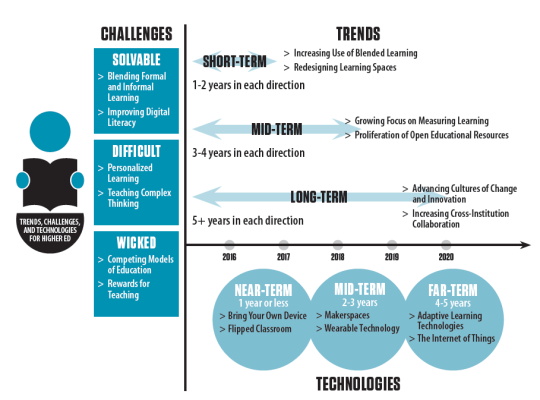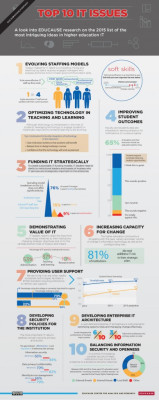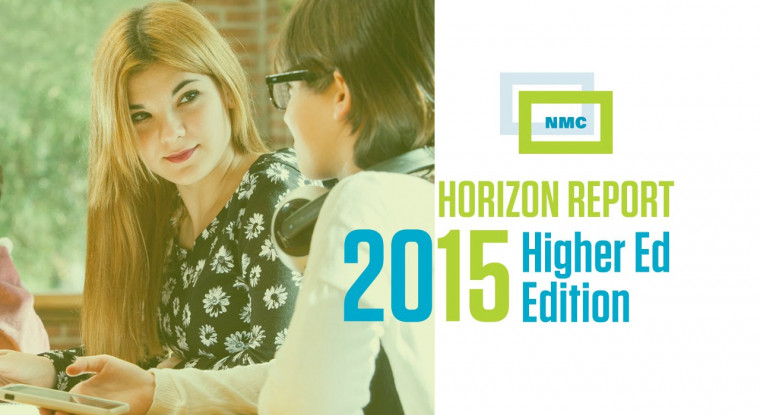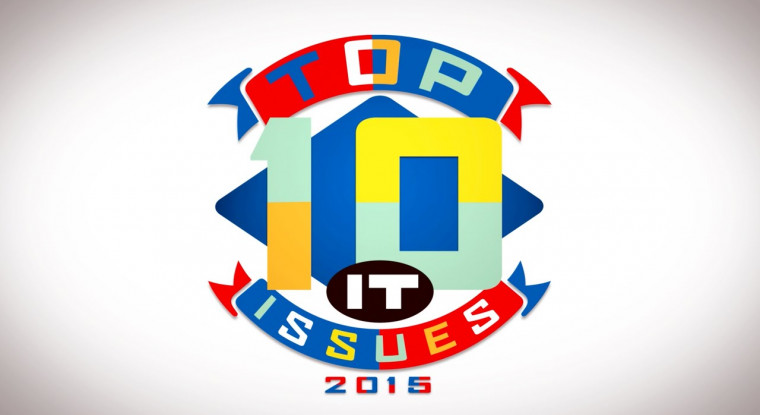Gartner Hype Cycle for Education 2015
“The digitalization of education is gaining momentum, moving into execution mode”
This is the opening quote in the Hype Cycle of Education 2015, the report published in July 2015 by the Gartner Research market research agency. The hype cycle shows how a new technology progresses through the cycle from promising to accepted product. When it does, there is a temporary and sometimes sharp fall halfway through the cycle.
According to Gartner these are the 2015 trends, spread across the five stages of development:
| On the Rise | The first phase is that of the Technology Trigger, (Innovation Trigger) where a new technology first attracts the attention of the press and the media. This can occur during a product launch for example. |
|
| At the Peak | This is the stage in which there are great expectations for the concept. The height of this phase is known as the Peak of Inflated Expectations. |
|
| Sliding Into the Trough | The Trough of Disillusionment is the phase in which the high hopes for the technology have burst and disappointment prevails |
|
| Climbing the Slope | The fourth phase shows a rising trend once again and is known as the Slope of Enlightenment. |
|
| Entering the Plateau | The fifth and final phase is the Plateau of Productivity, the phase in which the new technology becomes productive and starts to deliver returns. |
|
From the perspective of the SURFnet Customised Education innovation programme the following developments are of particular interest:
MOOC-Enabling Technologies (stadium: on the rise)
Although MOOCs no longer appear in the hype cycle in 2015 (because they quickly became accepted products), technologies that are included in the MOOCs do take a prominent position. An example of this is the use of innovative methods of using social learning or peer grading outside of the context of MOOCs. Gartner uses the following definition:“MOOC-enabling technologies are tools and platforms inspired by or replicating aspects of MOOCs and their ability to scale and facilitate learning using a combination of massive or open features.”
According to Gartner, technologies that are used in MOOCs show much promise for higher education because they facilitate new, didactic applications and can modernise on-campus teaching, enabling lecturers or educational institutions to serve larger groups of students. The business impact is described as follows: “MOOC-enabling technologies have the potential to have a big impact on student learning, as well as on the scalability of both education and outreach. A lot will depend on the ability of CIOs to develop policies around appropriate use of the tools and platforms. The tools and platforms will need to mature significantly, and cloud solutions will need to become more widely available.”
Personal Analytics (stadium: on the rise) / Learning Analytics (stadium: at the peak)
Big data, gamification and adaptive learning are on a downward slope; personal analytics however is on the rise and learning analytics is at the peak. Personal analytics involves the collection and analysis of (education) data by individual end users themselves and its impact on the choices that are made based on that data. So the emphasis here rests with students, as opposed to learning analytics, which actually involves the collection and analysis of data about users / students with the aim of improving teaching, the teaching environment and study success rates.
According to Gartner, educational institutions can take advantage of personal analytics by, for instance, providing students with training or tools that simplify analysis of their own personal data. Gartner has the following to say on the business impact of learning analytics: “When used effectively, learning analytics technologies have the potential to help identify problems in student learning paths at the level of the individual, the course, the program or the institution. As long as appropriate interventions are made to address those problems, the impact could be transformational, in that we could see great improvements in student learning outcomes.”
Digital assessment (stadium: on the rise)
Digital assessment is – surprisingly enough? – new in the hype cycle. Gartner uses the following definition: “Digital assessment refers to the application of digital technologies to create, administer, report and manage tests and examinations.” This is explicitly not the digitisation of existing tests but a new type of assessment which is stimulated by the growth of online education and new technological possibilities (such as the possibilities for checking someone’s identity).
Gartner describes the business impact as follows: “Digital assessment holds the promise of making significant improvements in how we understand, manage and improve learning. New platforms for the development and management of assessments are also a key component for online learning reaching full maturity and for the scalability of education.”
Competency-Based Education Platforms (stadium: on the rise)
Traditional education platforms are based on credits, contact hours and students who follow a more or less fixed curriculum. This is as opposed to education platforms that are based on competencies, self-directed learning (own time, own location), ‘mastery learning’ and the testing of competencies. More specifically, Gartner uses the following definition: “Competency-based education (CBE) is a way of organizing instruction based on the acquisition or possession of specified competencies by the learner. Traditional instruction is based on the credit hour and completion of a course by a set of students. CBE platforms are niche tools to support the new mode of instruction with more flexible systems that enable students to advance through courses at their own pace and with enhanced assessment functions to test the competencies.”
The business impact is described as follows: “The potential business impact is large. Competency-based learning has the potential to increase the scalability of learning while increasing the personalization. Also, with CBE there is the promise of increasing student learning — because the platforms test against mastery in a subject rather than simply passing a threshold set between a C and a D grade. So as students move to the next stage or module, they have mastered the knowledge they need in order to succeed at the next level. The self-paced nature of CBE platforms allows students to work through course work as quickly as they can and thus holds the promise to quicken the time to degree for at least some students.”
NMC Horizon Report 2015 Higher Education
Six trends, challenges and new technological developments
Each year the New Media Consortium and the Educause Learning Initiative publish the NMC Horizon Report which describes key trends, challenges and new technological developments in ICT and education. According to the NMC Horizon Report: 2015 Higher Education Edition published in February 2015, the six main trends in higher education in the years ahead are as follows:
Short-term (1-2 years)
- Increasing Use of Blended Learning
- Redesigning Learning Spaces
Mid-term (3-5 years)
- Growing Focus on Measuring Learning
- Proliferation of Open Educational Resources
Long-term (5+ years)
- Advancing Cultures of Change and Innovation
- Increasing Cross-Institution Collaboration

Along with these trends, six challenges are highlighted:
- De mix van formeel en informeel leren (en erkenning van informeel leren)
- Verbetering van digitale geletterdheid
- Gepersonaliseerd leren
- Teaching complex thinking (analyse van big data, semantisch web, modeling software)
- Concurrerende onderwijsmodellen
- Beloning van onderwijsprestaties
In the near term (<1 year) bring your own device and flipped classroom are the key technological developments, according to Horizon. In the medium term (3-5 years) there will be maker spaces and wearables (see also the SURFnet blogs on Google Glass experiments). In the longer term (5+ years) adaptive learning technologies and the internet of things will feature prominently.
The list of new technologies on pp.34-35 of the report is also interesting, with a distinction made between consumer technologies, digital strategies, enabling technologies, internet technologies, social media technologies and visualisation technologies.
Would you like to know more?
- download the NMC Horizon Report: 2015 Higher Education Edition
Top 10 IT Issues 2015 (Educause)
Top 10 IT issues 2015 according to Educause
In February 2015 Educause published the Top 10 IT issues in education and ICT, serving as input for ICT policy at higher education institutions:
- Hiring and retaining qualified staff, and updating the knowledge and skills of existing technology staff.
- Optimizing the use of technology in teaching and learning in collaboration with academic leadership, including understanding the appropriate level of technology to use.
- Developing IT funding models that sustain core service, support innovation, and facilitate growth.
- Improving student outcomes through an institutional approach that strategically leverages technology.
- Demonstrating the business value of information technology and how technology and the IT organization can help the institution achieve its goals.
- Increasing the IT organization’s capacity for managing change, despite differing community needs, priorities, and abilities.
- Providing user support in the new normal—mobile, online education, cloud, and BYOD environments.
- Developing mobile, cloud, and digital security policies that work for most of the institutional community.
- Developing an enterprise IT architecture that can respond to changing conditions and new opportunities.
- Balancing agility, openness, and security
> see also the additional resources

Inflection point
Similar to previous years the focus is on change, yet Educause has found that the pace at which changes are taking place has accelerated. There seems to be a turning point, where trends are not only being embraced by early adopters but are also becoming more mainstream – ‘the future is here’. Issues 1, 6, 9 and 10 exemplify the turnaround.
From Technical to Business
A second development that Educause has identified is a shift in focus from ICT / technology to the primary process. In other words, a shift from ‘using ICT in education’ (technology push) to ‘innovation in education and research through the use of ICT’. The consequence is that there is a greater need for collaboration among ICT departments and education and research departments at education institutions. Examples among the top 10 issues are 2, 3, 4 and 5.
The new normal
The third development is summarised as ‘the new normal’, where a large number of daily activities comprise facilitating cloud services, mobile devices, BYOD and online education or drawing up guidelines on their use. See issues 7 and 8.
Would you like to know more?
- Read the Top 10 IT Issues 2015
- interactive graph showing the top 10 IT issues in the period 2000-2015
In conclusion
On the face of it there seems to be little overlap with the trends described by Gartner, Horizon and Educause. Terms such as personal analytics and MOOC-enabling technologies do not appear in the Horizon report and no key trends in the report are highlighted as such in the hype cycle. This is partly due to the perspective taken in the various reports: Gartner focuses on the latest technologies that are interesting for the higher education sector, Horizon largely describes global trends and technologies that will impact higher education within five years while Educause largely zooms in on trends at the strategic level. The combined reports paint a good picture of trends and new technologies that might be interesting for the higher education sector.
lthough the education sector has sometimes been critical of the hype cycle and the Horizon Report (see for example Stephen Downes’ blog), it certainly is worthwhile reading the reports and forming your own opinion. Needless to say there are more thought-provoking sources that describe ICT trends, such as the ELI Content Anchors 2015, the iXperium Trend Report 2015 (HAN), het Kennisnet Trend Report 2014-2015, and the SURF’s Open Education Trend Report 2014.


0 Praat mee